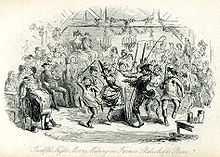Plough Monday



Plough Monday is the traditional start of the English agricultural year. While local practices may vary, Plough Monday is generally the first Monday after Twelfth Day (Epiphany), 6 January.[2][3] References to Plough Monday date back to the late 15th century.[3] The day before Plough Monday is sometimes referred to as Plough Sunday.
The day traditionally saw the resumption of work after the Christmas period. In some areas, particularly in northern England and East England, a plough was hauled from house to house in a procession, collecting money. They were often accompanied by musicians, an old woman or a boy dressed as an old woman, called the "Bessy", and a man in the role of the "fool". 'Plough Pudding' is a boiled suet pudding, containing meat and onions. It is from Norfolk and is eaten on Plough Monday.[2]
William Hone made use of Observations on the Popular Antiquities of Great Britain: Including the Whole of Mr. Bourne's Antiquitates Vulgares (1777) by the antiquary John Brand. Brand's work (with additions by Henry Ellis) mentions a northern English Plough Monday custom also observed in the beginning of Lent. Evidently the Plough dance depicted by Phiz in his illustrations for Harrison Ainsworth's 1858 novel Mervyn Clitheroe, and Ainsworth's description, is based on this or a similar account:[4]
| “ | The FOOL PLOUGH goes about: a pageant consisting of a number of sword dancers dragging a plough, with music; one, sometimes two, in very strange attire; the Bessy, in the grotesque habit of an old woman, and the Fool, almost covered with skins, a hairy cap on, and the tail of some animal hanging from his back. The office of one of these characters, in which he is very assiduous, is to go about rattling a box amongst the spectators of the dance, in which he receives their little donations.[5] | ” |
In the Isles of Scilly, locals would cross-dress and then visit their neighbours to joke about local occurrences. There would be guise dancing (folk-etymologically rendered as "goose dancing" by either the authors or those whom they observed) and considerable drinking and revelry.[6]
The Plough Monday customs declined in the 19th century but have been revived in the 20th. They are now mainly associated with Molly dancing and a good example can be seen each year at Maldon in Essex.
References
- ↑ Jo Draper (January 2010). "Plough Monday in Dorchester". Dorset Life Magazine. Retrieved 27 January 2014.
- ↑ 2.0 2.1 Hone, William (1826). The Every-Day Book. London: Hunt and Clarke. p. 71.
- ↑ 3.0 3.1 "Plough Monday". Oxford English Dictionary (online edition, subscription required). Retrieved 1 December 2006.
- ↑ "Hone's Every-Day Book". The material is omitted from the Plough Monday entry in the Revised edition of Brand of 1905.
- ↑ John Brand, Observations on Popular Antiquities (1777). Loc. in new edition with the additions of Sir Henry Ellis (Chatto and Windus, London 1900), p. 273-274.
- ↑ "Plough Monday", The Every-day Book and Table Book; or, Everlasting Calendar of Popular Amusements, Sports, Pastimes, Ceremonies, Manners, Customs, and Events, Each of the Three Hundred and Sixty-Five Days, in Past and Present Times; Forming a Complete History of the Year, Months, and Seasons, and a Perpetual Key to the Almanac, Including Accounts of the Weather, Rules for Health and Conduct, Remarkable and Important Anecdotes, Facts, and Notices, in Chronology, Antiquities, Topography, Biography, Natural History, Art, Science, and General Literature; Derived from the Most Authentic Sources, and Valuable Original Communication, with Poetical Elucidations, for Daily Use and Diversion. Vol III., ed. William Hone, (London: 1838) p 81. Retrieved on 6 June 2008
See also
- Royal Ploughing Ceremony in Southeast Asia
- Pluguşorul